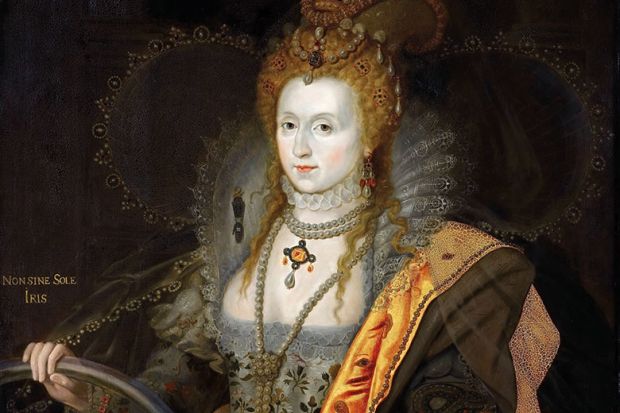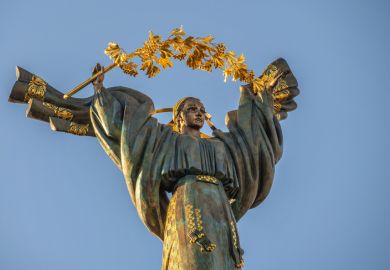On 6 December 1602, Elizabeth I attended a sumptuous housewarming party thrown by her chief minister Robert Cecil in his grand new mansion on the Strand in London. The elderly queen “bruised her shins”, stumbling as she boarded the barge to return to Whitehall, but she had clearly enjoyed herself. There had been a good dinner and, as was usual on these occasions, she had witnessed two entertainments, carefully designed, by Cecil and the poet and politician John Davies, to flatter her.
The first, as Elizabeth arrived, was a conventional “contention” between a wife, a widow and a maid for pre-eminence, concluding, in honour of the “Virgin Queen”, with a predictable victory for the maid. The second, a “Conference Between a Gentleman Usher and a Post” was odder: a humorous presentation of the delays and confusions as a postman (probably the first Chinese person to be depicted on the English stage) arrived to deliver a letter and a gift from the Emperor of China to the Queen of England. Matthew Dimmock identifies a fictional letter associated with Cecil as the one read at the climax of the drama and suggests also that the “rich mantle” offered as the gift was the famous cloak decorated with eyes and ears that Elizabeth wears in the Rainbow Portrait, which may well have been commissioned to commemorate her visit.
As Dimmock scrupulously acknowledges, the evidence for these connections is plausible but not conclusive. Nonetheless, in accepting his premises, readers are offered a fascinating reconstruction and contextualisation of Cecil’s party and its material and textual traces. The book links the December party to other entertainments and literary works, other portraits and representations of the Queen, other letters and diplomatic exchanges, and Elizabethan encounters with the wider world. It has wonderful illustrations of maps and globes, portraits, calligraphy, prints, textiles and porcelain. Where traditional scholarship presented Elizabethan England as an isolated, embattled Protestant nation, Dimmock’s context is “the global ambitions of the English court in the final years of Elizabeth’s reign”. Elizabethan globalism looked east, and was motivated by trade and diplomacy rather than religion. The author distinguishes it sharply from the 17th-century “western designs” that established colonial settlements in the Americas and were strongly influenced by Protestantism.
Elizabethan merchants, explorers and diplomats opened links up with Russia, Persia, Morocco and, above all, the Islamic Ottoman Empire, and by extension with the Mongols. In 1600, official Russian and Moroccan embassies were both in London for several months, and both ambassadors had striking portraits painted by local artists. The Elizabethan court learned to “talk globally” in elaborate letters exchanged with Islamic rulers, and the English became enthusiastic purchasers of eastern spices, textiles, porcelain and precious stones. But their “compelling fantasy” was to establish links with the mysterious, inaccessible Empire of China. Geographical knowledge of this empire was murky, confused and contradictory; voyages set off hopefully on many different routes, bearing beautifully decorated letters to the Emperor that were never delivered.
The letter connected by Dimmock to the 1602 festivities is an imagined reply to letters taken by Captain Benjamin Wood on an expedition of 1596 that had not been heard of for four years; as Cecil probably realised, the sailors had never reached China and had long perished. This letter is a clever, obvious fiction. Drawing on the language used in correspondence between Elizabeth and the Russian Tsar and the Ottoman Emperor, it was an exercise in wish-fulfilment that praised the “glorious Queen of England” and offered her subjects “every safety of passage and freedom of traffic in our kingdom as in their own”. In contrast to this “dream of China”, direct contact with the Empire was “a tale of geographical dead ends and expensive, tragic failure”.
If Elizabethan globalism was sometimes more aspiration than reality, it nonetheless required what Dimmock calls “internationally legible” representations of the Queen herself. Here, the rich mantle, identified as the Chinese-style textile of the Rainbow Portrait, is crucial to his account of the portrayals of the Queen in her last years. In contrast to the conventional understanding of her as a Protestant and English icon, as Deborah or a version of a classical goddess such as the huntress Diana or Astraea, who presided over an ancient golden age, the Rainbow Portrait represents Elizabeth as the goddess “Fame” but also as a “type” of the biblical Sheba, famous throughout the world. This latter image, writes Dimmock, was both “uniquely English” and “intended to be global in its legibility”. Its Old Testament origins helped to dilute the unease that surrounded Elizabeth’s engagement with the non-Christian East. Unlike the Queen of Sheba, who was a great traveller, the Queen of England had never left her own country. Yet she was successfully portrayed as famous throughout the world, not least for her extraordinary linguistic gifts. Many scholars have seen the Rainbow Portrait as strange, but Dimmock argues that it was meant to be – it represented the exotic, global reach of Elizabeth’s power: what more appropriate gift from the Emperor of China could be imagined than Fame’s mantle, presented to the Queen at the Cecil House entertainment?
On that December day, the courtiers gathered in Cecil’s house were thus drawn into a “dream of China”, a dream that was a product of genuine desire and dogged enterprise. The event, as Dimmock puts it, arose from a “uniquely Elizabethan set of circumstances and geopolitical perspective”. In opposition to Spanish claims to universal absolute monarchy, the Elizabethans championed commerce – considered to be mutually beneficial – including a profitable arms trade with non-Christian powers. This was obviously not benign, but Dimmock insists that there was “no seamless transition from a golden age of Elizabethan expansionism to a trans-continental British Empire”, and sees 17th-century moves towards “a colonialist model that looked acquisitively westward” as very different.
This contrast may be overdone, but Dimmock’s account of Elizabethan globalism is both vividly precise and highly significant. The book is an excellent and timely contribution to the recent scholarship challenging assumptions that the Elizabethan regime was introspective and xenophobic. Studies by historians, literary scholars and art historians increasingly investigate transcultural encounters, trade, travel and exploration, with a particular focus on links with the Islamic world. This book prompts fresh thinking about portrayals of the Queen, and of the global perspectives of both Elizabeth and Cecil. The latter had a passion for Chinese porcelain, alongside textiles and furniture from Persia and the Ottoman Empire. His house on the Strand, as Dimmock describes, was “a focal point for late Elizabethan engagement with the wider world”. Beyond Cecil House, the Strand was thronged with shops “glinting and shining with foreign wares”, while many humbler English homes had access to the spices, textiles, furniture and porcelain that came from an “East” that was both mysterious and increasingly familiar.
Ann Hughes is professor of early modern history, emerita, at Keele University.
Elizabethan Globalism: England, China and the Rainbow Portrait
By Matthew Dimmock
Yale University Press, 336pp, £50.00
ISBN 9781913107031
Published 8 October 2019
The author
Matthew Dimmock, professor of early modern studies at the University of Sussex, grew up in Yorkshire, Northamptonshire and Lincolnshire before attending the University of Leeds for both a BA and an MA in English. After taking a year out of academia, he returned to Royal Holloway, University of London for a PhD exploring the image of Islam and the Ottoman Empire in early modern English culture – and particularly the representation of “the terrible Turk” on the stage.
Armed with a doctorate, Dimmock immediately secured a visiting scholarship at Leiden University in the Netherlands, where “for three and a half cold but productive months”, he recalls, he “skated on canals, took courses in early Dutch, worked in the National Archives in The Hague, and taught on the MA in European expansion”. This was followed by a few months, again as a visiting scholar, at the Centre for Editing Lives and Letters at Queen Mary University of London. From there, in 2003, he took up a permanent position at Sussex as lecturer in English literature, from which he was promoted 10 years later to a professorship. He has since, he says, “moved all over Sussex in search of a sea view, and am now based in lovely Seaford, where on tiptoes I can just about catch a glimpse of it from an attic window”.
Fascinated by “notions of ‘otherness’ that concern cultural, racial and religious difference”, Dimmock is the author of New Turkes: Dramatizing Islam and the Ottomans in Early Modern England (2005) and Mythologies of the Prophet Muhammad in Early Modern English Culture (2013) as well as Elizabethan Globalism. He is now working on a project about the Elizabethan navigator and explorer John Davis (1550-1605).
Matthew Reisz
POSTSCRIPT:
Print headline: Elizabeth and the technicolour dreamcoat
Register to continue
Why register?
- Registration is free and only takes a moment
- Once registered, you can read 3 articles a month
- Sign up for our newsletter
Subscribe
Or subscribe for unlimited access to:
- Unlimited access to news, views, insights & reviews
- Digital editions
- Digital access to THE’s university and college rankings analysis
Already registered or a current subscriber? Login







